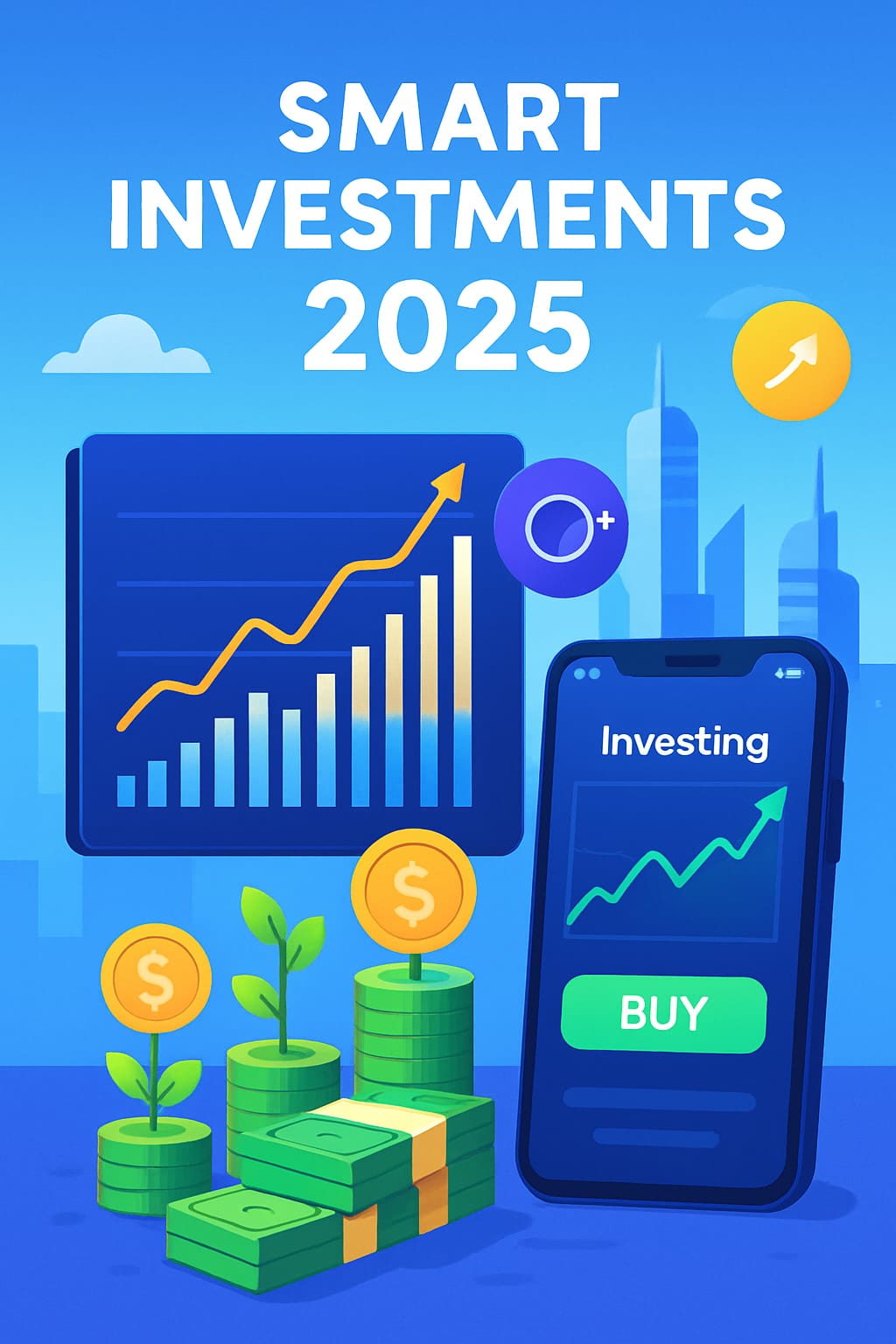Table of Contents
- Introduction: Why 2025 is the Best Year to Start Investing
- Can You Really Build Wealth with Little Money?
- Golden Rules of Smart Investing
- Start Small, Start Early
- The Power of Compounding
- Balancing Risks and Rewards
- Consistency Over Perfection
- Best Smart Investment Options in 2025
- High-Yield Savings Accounts & Neobanks
- Stock Market for Beginners (ETFs & Index Funds)
- Fractional Share Investing: Owning Giants in Small Steps
- Real Estate Crowdfunding
- Mutual Funds vs ETFs (Detailed Table)
- Cryptocurrency in 2025: Risk vs Reward
- Gold, Bonds, and Commodities
- Side Hustle Investments (Digital Businesses)
- Step-by-Step Guide: How to Start Investing with Just $100 (or ₹1000)
- Real-Life Case Studies: From Small Investments to Big Growth
- Risk Management: Protecting Your Small Capital
- How Technology & AI Make Investing Easier in 2025
- How Inflation in 2025 is Quietly Eating Your Money
- Habits of Successful Small Investors
- Motivational Conclusion: Your Financial Freedom Journey
- FAQs: Simple Answers for Beginners
- Professional Disclaimer
1. Introduction: Why 2025 is the Best Year to Start Investing
2025 is one of the best years in history to start investing with small amounts. Why? Because technology has changed the way money works:
- You no longer need lakhs of rupees to invest.
- With mobile apps, you can start for as little as ₹100 or $5.
- New financial platforms make investing faster, simpler, and safer than ever.
The earlier generation needed brokers, paperwork, and large deposits. Today, if you have a smartphone, internet, and discipline, you can grow wealth step by step.
👉 Imagine this: Instead of spending ₹500 (price of a pizza) every week, if you invest the same amount in ETFs or fractional stocks for 10 years, you could accumulate lakhs of rupees!
This blog will give you smart, easy-to-apply tips for 2025—so even with little money, you can start building a strong financial future.

2. Can You Really Build Wealth with Little Money?
Short answer: Yes, absolutely!
Most people think investing is only for the rich. But that’s a myth. The truth is, even small amounts grow significantly with discipline and time.
👉 Example (India): If you invest ₹1000 every month in a Nifty 50 index fund, in 10 years (with ~12% annual return), it becomes nearly ₹2.3 lakhs.
👉 Example (US): A $100 monthly investment in the S&P 500 ETFs for 20 years could grow into $77,000+.
So the secret isn’t just putting in *big money, it’s about *starting early and staying consistent.
3. Golden Rules of Smart Investing
a) Start Small, Start Early
Don’t wait until you “have enough money.” Start with whatever you can right now—even ₹500 or $5.
b) The Power of Compounding
Compounding = earning interest on your previous interest. The longer you invest, the bigger the snowball effect becomes.
- ₹1000/month for 10 years → ₹2 lakhs
- ₹1000/month for 30 years → ₹12 lakhs (6X bigger, because of compounding)
c) Balancing Risks and Rewards
Safe investments = lower returns. Riskier = higher returns. Smart investors balance both.
d) Consistency Over Perfection
Even if you invest small amounts, consistency beats timing. Missing opportunities is worse than small mistakes.

4. Best Smart Investment Options in 2025
4.1 High-Yield Savings Accounts & Neobanks
Digital or “neo” banks in 2025 give 5–7% interest, much more than traditional banks. Great for emergency funds.
4.2 Stock Market for Beginners: ETFs & Index Funds
- Index funds: Track Nifty 50 or S&P 500.
- ETFs: Trade like shares, very low-cost.
- Average return: 10–12% annually (long-term).
Recommended 2025 beginner picks:
- India: Nifty 50 ETF, Sensex ETF
- US: S&P 500 ETF (SPY, VOO)
4.3 Fractional Share Investing
Now you don’t need ₹2500 to buy Tesla. You can buy a piece of it with ₹100. Great way for beginners to own expensive global companies.
4.4 Real Estate Crowdfunding
Platforms allow ₹5000–₹10,000 investment in properties. You earn from rent + property appreciation.
4.5 Mutual Funds vs. ETFs
| Aspect | Mutual Funds | ETFs |
|---|---|---|
| Minimum Investment | ₹500–₹1000 SIP | As little as 1 share |
| Fees | Higher (1–2%) | Very Low (0.1–0.5%) |
| Liquidity | Medium | High (real-time sell) |
| Best For | Long-term beginners | Active or passive traders |
4.6 Cryptocurrency in 2025
- Limit crypto to 5% of your portfolio
- Safer options: Bitcoin, Ethereum, Central Bank Digital Currencies (CBDCs)
- Avoid “pump and dump” meme coins
4.7 Gold, Bonds & Commodities
Gold ETFs and Sovereign Gold Bonds (SGBs) protect against inflation. Always keep 5–10% of portfolio in gold.
4.8 Side Hustle Investments
Don’t ignore digital businesses: blogging, dropshipping, affiliate marketing. Many people earn passive income streams by investing small amounts in skills + tools.

5. Step-by-Step Guide: Start with Just $100 (₹1000)
Here’s a simple plan for 2025:
- 40% (₹400/$40): Low-cost index fund (S&P 500/Nifty 50)
- 20% (₹200/$20): Fractional shares of global companies
- 20% (₹200/$20): Gold/Sovereign Bonds
- 10% (₹100/$10): Crypto (for growth potential)
- 10% (₹100/$10): High-yield digital savings for emergencies
6. Real-Life Case Studies
Case 1: Akash, 24 (India)
Saved ₹500 weekly → invested in Nifty ETF. By 2025, portfolio worth ₹1.5 lakhs.
Case 2: Sarah, 30 (US)
Bought $20 worth of Tesla shares monthly since 2018 → 5X return by 2025.
Case 3: Ravi, 28 (India)
Invested ₹5000 via real estate crowdfunding → now earning ₹500/month rental share.
7. Risk Management
- Diversify across multiple assets
- Avoid high-interest debt before investing
- Never invest on “hot tips”
- Use only SEBI/SEC approved platforms
8. Role of AI & Technology
2025 brings AI-powered robo-advisors that:
- Suggest portfolios based on age/income
- Auto-balance risk/reward
- Send smart alerts when markets move
Apps like Zerodha, Groww, Robinhood, Paytm Money make investing possible even for college students.
9. Inflation in 2025: Silent Wealth Killer
India: ~5–6%
US: ~3%
If your savings account gives 2% but inflation is 5%, you’re losing money in reality. That’s why investing is essential.

10. Habits of Successful Small Investors
✅ Invest first, spend later
✅ Be consistent with SIPs
✅ Read at least one finance book yearly
✅ Don’t panic-sell in market crashes
✅ Treat investing like a long-term journey
11. Conclusion
Anyone can build wealth in 2025—even with ₹500 or $10. The secret isn’t about big capital, it’s about consistency, learning, and starting today.
💡 Remember: The best time to start investing was yesterday. The second-best time is NOW.
12. FAQs
Q1: Can I become rich by investing small amounts?
Yes, if you’re consistent for years and leverage compounding.
Q2: Which is safer—mutual funds or crypto?
Mutual funds (index funds/ETFs) are much safer than crypto.
Q3: How much should beginners invest in crypto?
Maximum 5% of your portfolio.
Q4: Should I focus on saving or investing?
Do both. First save 3–6 months emergency fund, then invest consistently.
Q5: Which is better in 2025—gold or stocks?
Gold protects your wealth; stocks grow your wealth. A balance of both works best.
13. Disclaimer
The information provided in this article, “Smart Investment Tips for 2025: How to Grow Your Wealth Fast With Little Money”, is shared only for educational and informational purposes. It should not be considered as financial, investment, tax, or legal advice.
All types of investments come with certain levels of risk, including the possible loss of your principal amount. Past performance of stocks, mutual funds, ETFs, cryptocurrencies, real estate, or any other asset class should not be relied upon as an indicator of future returns. The financial markets can be highly unpredictable and may be affected by factors such as economic conditions, inflation, interest rates, policy changes, and global events.
While we strive to provide correct, updated, and useful information, no guarantee is given regarding accuracy, reliability, or completeness. Any examples, charts, or case studies discussed are purely illustrative and should not be treated as actual predictions or promises of results.
Before making any financial decision, readers are strongly encouraged to perform their own research and seek guidance from a licensed financial advisor or other qualified professional.
By using this information, you agree that the author(s) and publisher(s) are not responsible or liable for any financial losses, damages, or unfavorable outcomes that may result from your actions.
👉 Invest wisely, stay informed, and never risk money you cannot afford to lose.
Trusted links
Securities and Exchange Board of India (SEBI) – https://www.sebi.gov.in
National Stock Exchange of India (NSE) – https://www.nseindia.com
Reserve Bank of India (RBI) – https://www.rbi.org.in
U.S. Securities and Exchange Commission (SEC) – https://www.sec.gov
Investopedia – https://www.investopedia.com
Real Estate Crowdfunding Guide (India) – https://www.loansjagat.com/blog/how-to-invest-in-real-estate-crowdfunding-platforms

